Charles, Duke of Brittany
| Blessed Charles of Blois-Châtillon | |
|---|---|
 | |
| Duke of Brittany | |
| Reign | 30 April 1341 – 29 September 1364 |
| Predecessor | John III |
| Successor | John IV |
| Born |
c. 1319 Blois (France) |
| Died |
29 September 1364 (aged 44–45) Auray |
| Spouse | Joanna, Duchess of Brittany |
| Issue |
John I of Blois-Châtillon Guy Henry Marie, Lady of Guise Margaret, Countess of Angoulême |
| House | House of Blois |
| Father | Guy I of Blois-Châtillon |
| Mother | Margaret of Valois |
| Charles de Châtillon | |
|---|---|
| Duke of Britanny Patron of Europe | |
| Died | Auray |
| Venerated in | Roman Catholicism |
| Beatified | 1904 by Pope Pius X |
| Canonized | 1364 (annulled) by Pope Urban V |
| Feast | 29 September (General Roman Calendar) |
| Patronage |
-Army soldiers -Agricultural workers |
Charles of Blois-Châtillon (1319 – 29 September 1364) "the Saint", was the legalist Duke of Brittany from 1341 to his death via his marriage to Joan of Penthiève, holding the title against the claims of John of Montfort. He was later canonized as a Saint of the Roman Catholic Church for his devotion to religion. This canonization was later annulled, although he remains beatified.
Biography
Charles was born in Blois, son of Guy de Châtillon, count of Blois, by Margaret of Valois, a sister of king Philip VI of France. An devout ascetic from an early age, he showed interest in religious books but was forbidden from reading them by his father, as they did not seem appropriate to his position as a knight.[1] As he grew older, Charles took piety to the extreme of mortifying his own flesh.[2] It is said that he placed pebbles in his shoes, wore ropes tight with knots near his flesh, slept on straw instead of a bed, confessed every night in fear of sleeping in a state of sin, and wore a cilice under his armor in battle. He was nevertheless an accomplished military leader, who inspired loyalty by his religious fervour.[1]
On 4 June 1337 in Paris, he married Joanna of Penthièvre, heiress and niece of duke John III.[3][1] Together, Charles and Joanna de Châtillon fought the House of Montfort in the Breton War of Succession (1341–1364), with the support of the crown of France.[1] Despite his piety, Charles did not hesitate in ordering the massacre of 1400 civilians after the siege of Quimper.[4] After initial successes, Charles was taken prisoner by the English in 1347.[1] His official captor was Thomas Dagworth.[5]
He stayed nine years as prisoner in the Kingdom of England. During that time, he used to visit English graveyards, where he prayed and recited Psalm 130 much to the chagrin of his own squire. When Charles asked the squire to take part in the prayer, the younger man refused, saying that the men who were buried at the English graveyards had killed his parents and friends and burned their houses.[1]
Charles was released against a ransom of about half a million écus in 1356.[6] Upon returning to France, he decided to travel barefoot in winter from La Roche-Derrien to Tréguier Cathedral out of devotion to Saint Ivo of Kermartin. When the common people heard of his plan, they placed straw and blankets on the street, but Charles promptly took another way. His feet became so sore that he could not walk for 15 weeks.[1] He then resumed the war against the Montforts.[7] Charles was eventually killed in combat during the Battle of Auray in 1364, which with the second treaty of Guerande in 1381, determined the end of the Breton War of Succession as a victory for the Montforts.[8]
Family
By his marriage to Joanna, he had five children:
- John (Jean) I of Châtillon (1340–1404), also known as Jean de Blois
- Guy
- Henri (d. 1400)
- Marie (1345–1404), Lady of Guise, married in 1360 Louis I, Duke of Anjou
- Marguerite, married in 1351 Charles de la Cerda (d. 1354)
According to Froissart's Chronicles, Charles also had an illegitimate child, Johann of Blois, who died in the Battle of Auray. Considering Charles' extreme piety, historian Johan Huizinga regarded it unlikely that Charles actually had a child born outside marriage, and that Jean Froissart was probably mistaken in identifiying Johann as Charles' son.[2]
Legacy
After his death, his family successfully lobbied for his canonization as a Saint of the Roman Catholic church for his devotion to religion.[2] The canonization process was nullified by Pope Gregory XI at the request of Duke John IV of Brittany, Charles' final opponent in the Breton War of Succession and the recognized Duke of Brittany under the first Treaty of Guerande.
Subsequently, in 1904, Charles de Châtillon was beatified and therefore may be referred to as the Blessed Charles of Blois. His Roman Catholic Feast Day is 30 September.[lower-alpha 1]
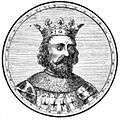 Image of S.Charles de Châtillon in the book Vie des Saints", Yann-Vari Perrot, publishing in 1912 (page 692)
Image of S.Charles de Châtillon in the book Vie des Saints", Yann-Vari Perrot, publishing in 1912 (page 692) The Saint Charles de Châtillon de Blois, battles gallery, Versailles castle, France
The Saint Charles de Châtillon de Blois, battles gallery, Versailles castle, France- The Saint Charles de Châtillon in the glass window of the Church Saint-Pierre in Plounéour-Trez, France
- The Saint Charles de Châtillon in the glass window of the Church Saint-Malo in Dinan, France
- Statue of Blessed Knight Charles Châtillon de Blois in the Church of Notre-Dame de Bulat-Pestivien (Bretagne)
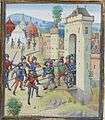 The Knight Charles de Blois-Châtillon, with is army, in the attack of Siege of Hennebont in 1342, an epic battle during the war of succession of Brittany
The Knight Charles de Blois-Châtillon, with is army, in the attack of Siege of Hennebont in 1342, an epic battle during the war of succession of Brittany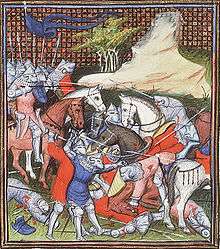 "The Knight Charles de Châtillon is taken prisoner". Jean Froissart, Chroniques (Vol. I), Koninklijke Bibliotheek in 1816
"The Knight Charles de Châtillon is taken prisoner". Jean Froissart, Chroniques (Vol. I), Koninklijke Bibliotheek in 1816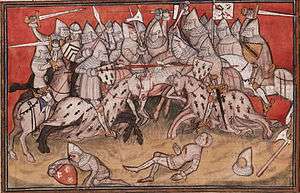 Battle of Auray, 1364
Battle of Auray, 1364 "War of Breton Succession" (1341–1364), Jean Froissart, Paris, 9th century
"War of Breton Succession" (1341–1364), Jean Froissart, Paris, 9th century_Basilique_Notre-Dame-de-Bonne-Nouvelle_Vitrail_1.jpg) Battle of Auray in the glass window of the Church of Notre-Dame-de-Bonne-Nouvelle, Rennes
Battle of Auray in the glass window of the Church of Notre-Dame-de-Bonne-Nouvelle, Rennes Battle of Auray 1364, "Chroniques"
Battle of Auray 1364, "Chroniques"- Battle of Auray, Bibliothèque Nationale de France, Paris
.png) First Siege of Vannes in 1342 by Charles de Blois-Châtillon
First Siege of Vannes in 1342 by Charles de Blois-Châtillon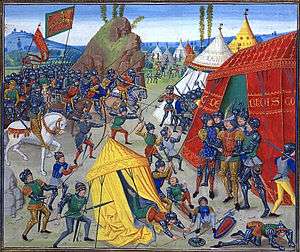 Charles de Blois-Châtillon, was taken prisoner after the battle of Roche Derrien in 1347
Charles de Blois-Châtillon, was taken prisoner after the battle of Roche Derrien in 1347
See also
Notes
- ↑ See the Franciscan Description of the Blessed Charles of Blois
References
- 1 2 3 4 5 6 7 Huizinga (2016), p. 289.
- 1 2 3 Huizinga (2016), p. 290.
- ↑ Michael Prestwich, The Three Edwards: War and State in England, 1272-1377, (Routledge, 1993), 174.
- ↑ Jonathan Sumption, The Hundred Years War, Volume 1: Trial by Battle, (Faber & Faber, 1999), 434.
- ↑ Michael Jones, Creation of Brittany: A Late Medieval State, (The Hambledon Press, 1988), 265.
- ↑ France under Charles V and Charles VI, Francoise Autrand, The New Cambridge Medieval History: Volume 6, C.1300-c.1415, ed. Michael Jones, (Cambridge University Press, 2000), 441.
- ↑ France under Charles V and Charles VI, Francoise Autrand, The New Cambridge Medieval History: Volume 6, C.1300-c.1415, ed. Michael Jones, (Cambridge University Press, 2000), 441.
- ↑ France under Charles V and Charles VI, Francoise Autrand, The New Cambridge Medieval History: Volume 6, C.1300-c.1415, ed. Michael Jones, (Cambridge University Press, 2000), 441.
Bibliography
- Huizinga, Johan (2016) [1st pub. 1919]. Herbst des Mittelalters [The Autumn of the Middle Ages] (in German). Translated by Kurt Köster (4th ed.). Stuttgart: Reclam. ISBN 978-3-15-020366-8.
External links
| Wikisource has the text of the 1911 Encyclopædia Britannica article Charles (Duke of Brittany). |
- The Saint Charles of Blois Chattilon

- Treccani.it, l'Enciclopedia italiana
- House of de Châtillon (-sur-Marne), Champagne (Soissonnais),Bourgogne, Ponthieu & Ternois, Genealogy and Heraldry
- House of de Nanteuil Le-Haudouin, Genealogy and Heraldry
Charles, Duke of Brittany Born: 1319 Died: 1364 | ||
| Regnal titles | ||
|---|---|---|
| Preceded by John III |
Duke of Brittany jure uxoris 1341–1364 With: Joan disputed by John of Montfort and John IV |
Succeeded by John IV |
| Preceded by Joan as sole countess |
Count of Penthièvre jure uxoris 1337–1364 With: Joan |
Succeeded by Joan as sole countess |